engine Citroen C4 AIRCROSS 2017 1.G Workshop Manual
[x] Cancel search | Manufacturer: CITROEN, Model Year: 2017, Model line: C4 AIRCROSS, Model: Citroen C4 AIRCROSS 2017 1.GPages: 368, PDF Size: 11.54 MB
Page 175 of 368
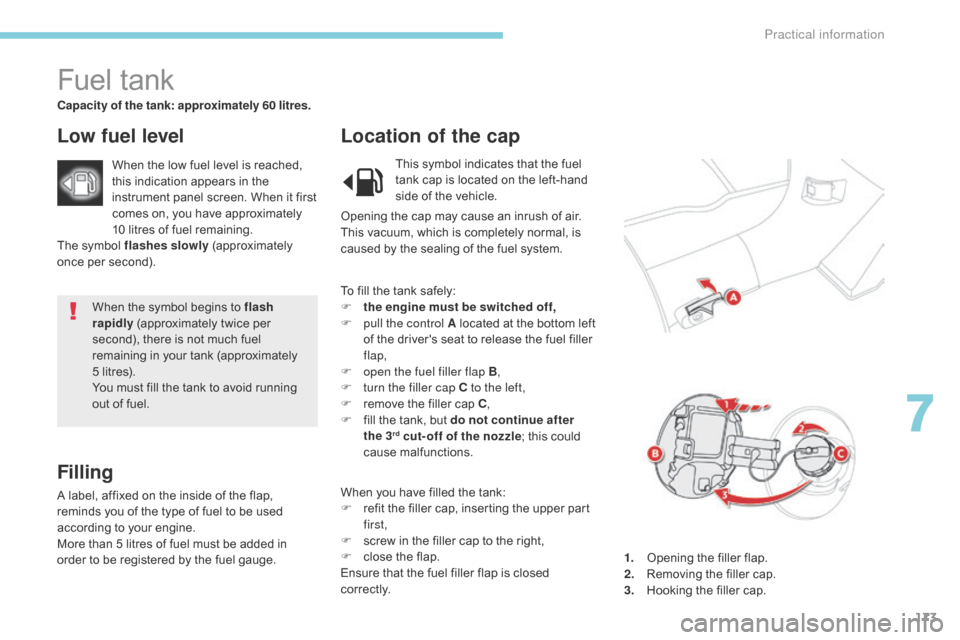
173
C4-Aircross_en_Chap07_info-pratiques_ed01-2016
When the symbol begins to flash
rapidly (approximately twice per
second), there is not much fuel
remaining in your tank (approximately
5
litres).
You must fill the tank to avoid running
out of fuel.
Fuel tank
Capacity of the tank: approximately 60 litres.
Low fuel level
Filling
A label, affixed on the inside of the flap,
reminds you of the type of fuel to be used
according to your engine.
More than 5 litres of fuel must be added in
order to be registered by the fuel gauge.
Location of the cap
When the low fuel level is reached,
this indication appears in the
instrument panel screen. When it first
comes on, you have approximately
10 litres of fuel remaining.
The symbol flashes slowly (approximately
once per second).
1.
O
pening the filler flap.
2.
R
emoving the filler cap.
3.
H
ooking the filler cap.
To fill the tank safely:
F
t
he engine must be switched off,
F
p
ull the control A located at the bottom left
of the driver's seat to release the fuel filler
flap,
F
o
pen the fuel filler flap B,
F
t
urn the filler cap C to the left,
F
r
emove the filler cap C,
F
f
ill the tank, but do not continue after
the
3
rd cut- off of the nozzle; this could
cause malfunctions.
When you have filled the tank:
F
r
efit the filler cap, inserting the upper part
first,
F
s
crew in the filler cap to the right,
F
c
lose the flap.
Ensure that the fuel filler flap is closed
c o r r e c t l y. This symbol indicates that the fuel
tank cap is located on the left-hand
side of the vehicle.
Opening the cap may cause an inrush of air.
This vacuum, which is completely normal, is
caused by the sealing of the fuel system.
7
Practical information
Page 176 of 368
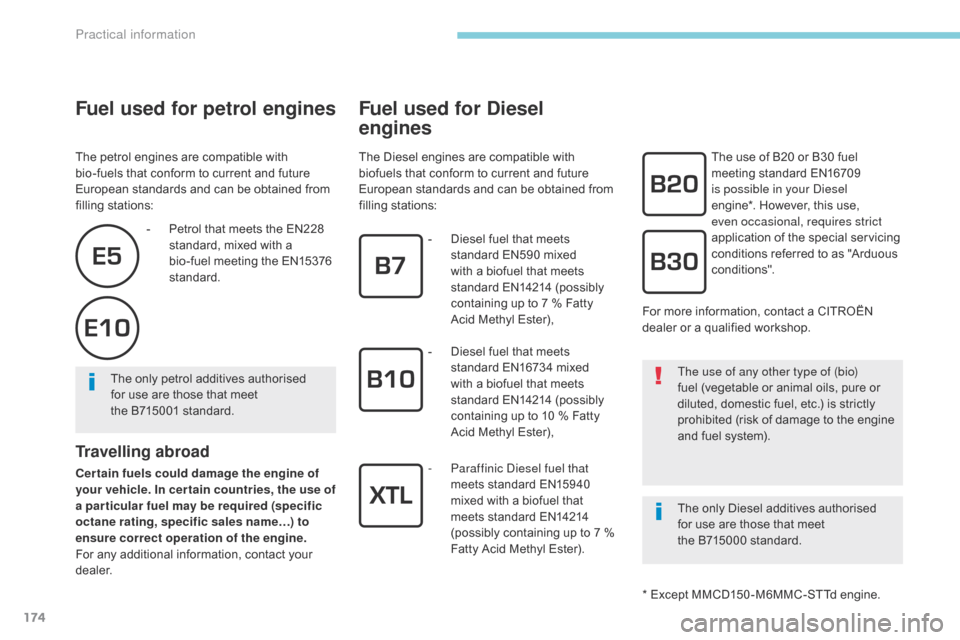
174
C4-Aircross_en_Chap07_info-pratiques_ed01-2016
Fuel used for petrol engines
The petrol engines are compatible with
bio-fuels that conform to current and future
European standards and can be obtained from
filling stations:
Travelling abroad
Cer tain fuels could damage the engine of
your vehicle. In cer tain countries, the use of
a par ticular fuel may be required (specific
octane rating, specific sales name…) to
ensure correct operation of the engine.
For any additional information, contact your
dealer.-
Pe
trol that meets the EN228
standard, mixed with a
bio-fuel meeting the EN15376
standard.
The only petrol additives authorised
for use are those that meet
the B715001 standard.
Fuel used for Diesel
engines
The Diesel engines are compatible with
biofuels that conform to current and future
European standards and can be obtained from
filling stations: The use of B20 or B30 fuel
meeting standard EN16709
is possible in your Diesel
engine*. However, this use,
even occasional, requires strict
application of the special servicing
conditions referred to as "Arduous
conditions".
-
D
iesel fuel that meets
standard EN590 mixed
with a biofuel that meets
standard
EN14214 (possibly
containing up to 7 % Fatty
Acid Methyl Ester),
-
D
iesel fuel that meets
standard EN16734 mixed
with a biofuel that meets
standard
EN14214 (possibly
containing up to 10 % Fatty
Acid Methyl Ester),
-
P
araffinic Diesel fuel that
meets standard EN15940
mixed with a biofuel that
meets standard EN14214
(possibly containing up to 7 %
Fatty Acid Methyl Ester). For more information, contact a CITROËN
dealer or a qualified workshop.
The use of any other type of (bio)
fuel (vegetable or animal oils, pure or
diluted, domestic fuel, etc.) is strictly
prohibited (risk of damage to the engine
and fuel system).
The only Diesel additives authorised
for use are those that meet
the B715000 standard.
* Except MMCD150 -M6MMC-STTd engine.
Practical information
Page 178 of 368
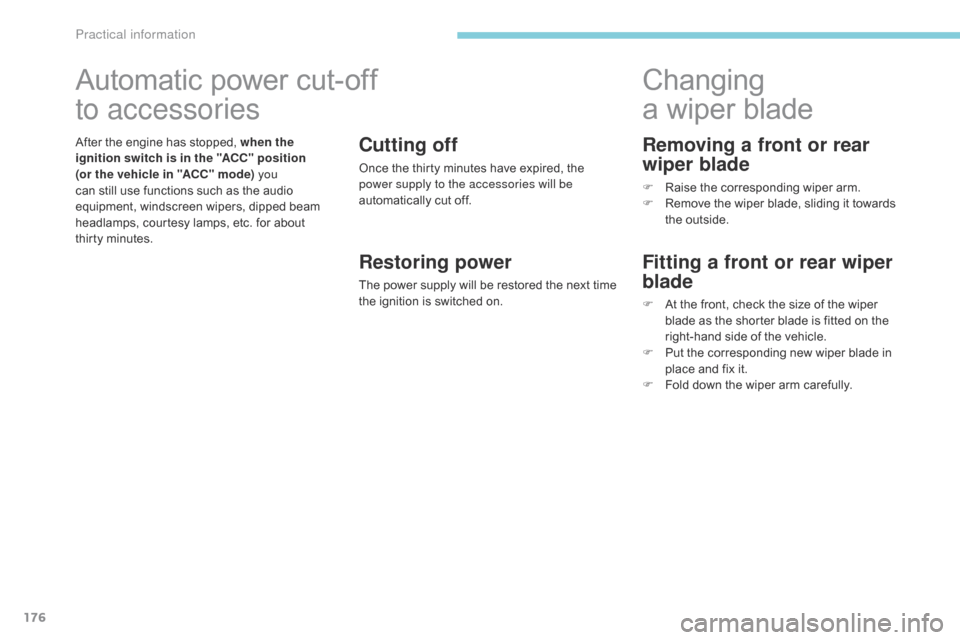
176
C4-Aircross_en_Chap07_info-pratiques_ed01-2016
Removing a front or rear
wiper blade
F Raise the corresponding wiper arm.
F R emove the wiper blade, sliding it towards
the outside.
Changing
a wiper blade
Fitting a front or rear wiper
blade
F At the front, check the size of the wiper
blade as the shorter blade is fitted on the
right-hand side of the vehicle.
F
P
ut the corresponding new wiper blade in
place and fix it.
F
F
old down the wiper arm carefully.
Automatic power cut-off
to accessories
After the engine has stopped, when the
ignition switch is in the "ACC" position
(or the vehicle in "ACC" mode) you
can still use functions such as the audio
equipment, windscreen wipers, dipped beam
headlamps,
courtesy lamps, etc. for about
thirty
m
inutes.Cutting off
Once the thirty minutes have expired, the
power supply to the accessories will be
automatically cut off.
Restoring power
The power supply will be restored the next time
the ignition is switched on.
Practical information
Page 180 of 368
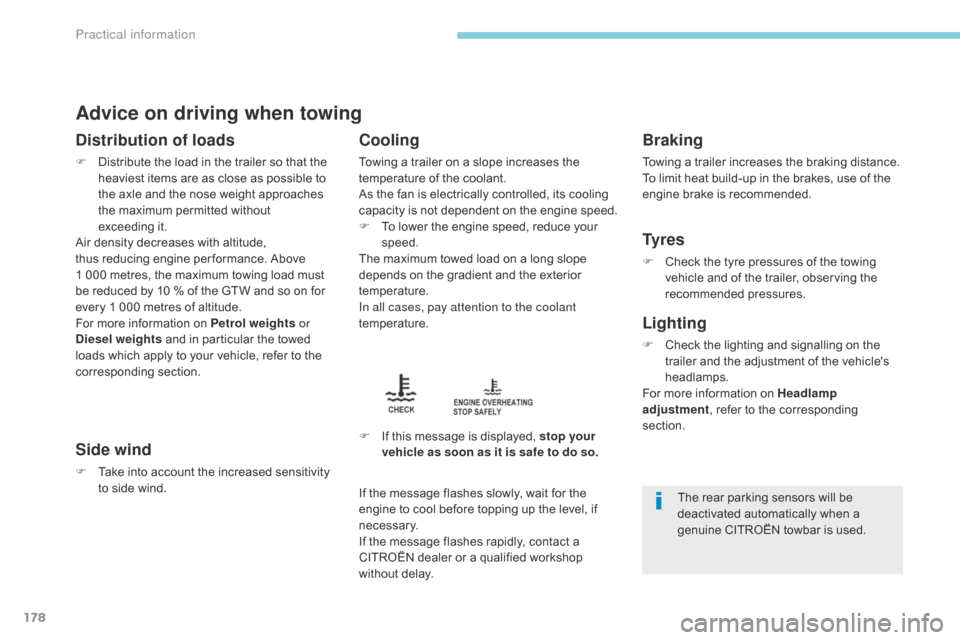
178
C4-Aircross_en_Chap07_info-pratiques_ed01-2016
Advice on driving when towing
Distribution of loads
F Distribute the load in the trailer so that the heaviest items are as close as possible to
the axle and the nose weight approaches
the maximum permitted without
exceeding
it.
Air density decreases with altitude,
thus
reducing engine per formance. Above
1
000 metres, the maximum towing load must
be reduced by 10
% of the GTW and so on for
every 1
000 metres of altitude.
For more information on Petrol weights or
Diesel weights and in particular the towed
loads which apply to your vehicle, refer to the
corresponding section.
Side wind
F Take into account the increased sensitivity to side wind.
Cooling
Towing a trailer on a slope increases the
temperature of the coolant.
As the fan is electrically controlled, its cooling
capacity is not dependent on the engine speed.
F
T
o lower the engine speed, reduce your
speed.
The maximum towed load on a long slope
depends on the gradient and the exterior
temperature.
In all cases, pay attention to the coolant
temperature.
F
I
f this message is displayed, stop your
vehicle as soon as it is safe to do so.
Braking
Towing a trailer increases the braking distance.
To limit heat build-up in the brakes, use of the
engine brake is recommended.
Ty r e s
F Check the tyre pressures of the towing vehicle and of the trailer, observing the
recommended pressures.
Lighting
F Check the lighting and signalling on the trailer and the adjustment of the vehicle's
headlamps.
For more information on Headlamp
adjustment , refer to the corresponding
section.
If the message flashes slowly, wait for the
engine to cool before topping up the level, if
necessary.
If the message flashes rapidly, contact a
CITROËN dealer or a qualified workshop
without delay.
The rear parking sensors will be
deactivated automatically when a
genuine CITROËN towbar is used.
Practical information
Page 182 of 368
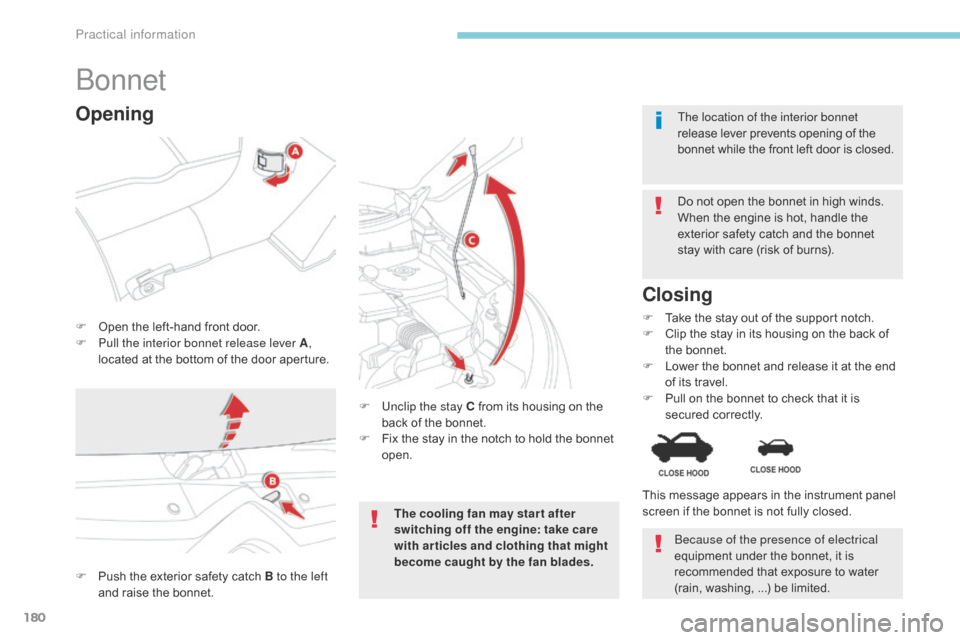
180
C4-Aircross_en_Chap07_info-pratiques_ed01-2016
Bonnet
F Open the left-hand front door.
F P ull the interior bonnet release lever A ,
located at the bottom of the door aperture. Do not open the bonnet in high winds.
When the engine is hot, handle the
exterior safety catch and the bonnet
stay with care (risk of burns).
F
U
nclip the stay C from its housing on the
back of the bonnet.
F
F
ix the stay in the notch to hold the bonnet
open.
Closing
F Take the stay out of the support notch.
F C lip the stay in its housing on the back of
the bonnet.
F
L
ower the bonnet and release it at the end
of its travel.
F
P
ull on the bonnet to check that it is
secured correctly. The location of the interior bonnet
release lever prevents opening of the
bonnet while the front left door is closed.
Opening
F Push the exterior safety catch B to the left
and raise the bonnet. This message appears in the instrument panel
screen if the bonnet is not fully closed.
The cooling fan may star t after
switching off the engine: take care
with articles and clothing that might
become caught by the fan blades.
Because of the presence of electrical
equipment under the bonnet, it is
recommended that exposure to water
(rain, washing, ...) be limited.
Practical information
Page 183 of 368
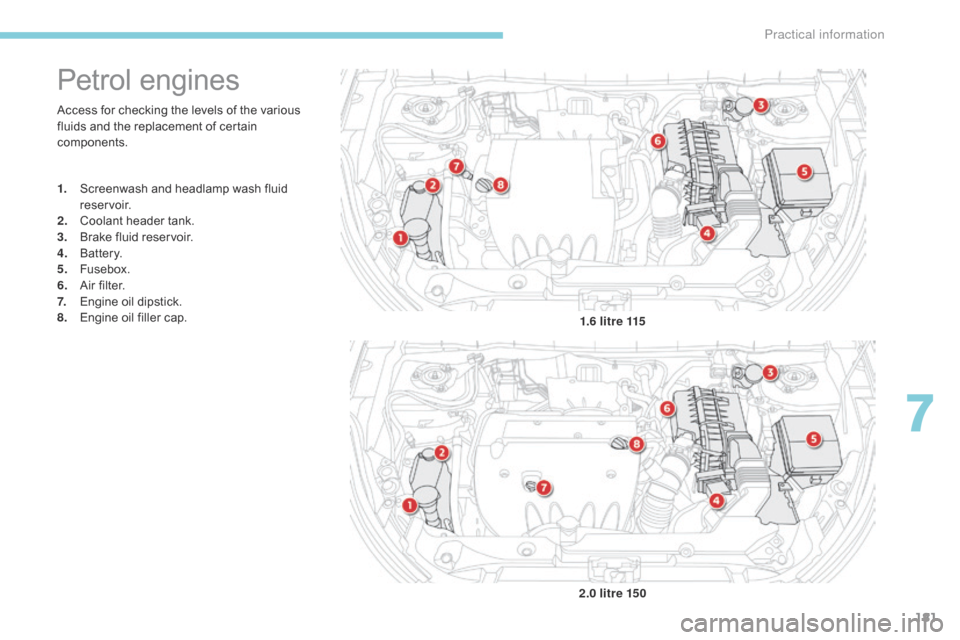
181
C4-Aircross_en_Chap07_info-pratiques_ed01-2016
Access for checking the levels of the various
fluids and the replacement of certain
components.
Petrol engines
1. Screenwash and headlamp wash fluid reservoir.
2.
C
oolant header tank.
3.
B
rake fluid reservoir.
4.
B
attery.
5.
F
usebox.
6.
A
ir filter.
7.
E
ngine oil dipstick.
8.
E
ngine oil filler cap. 1.6 litre 115
2.0 litre 150
7
Practical information
Page 184 of 368
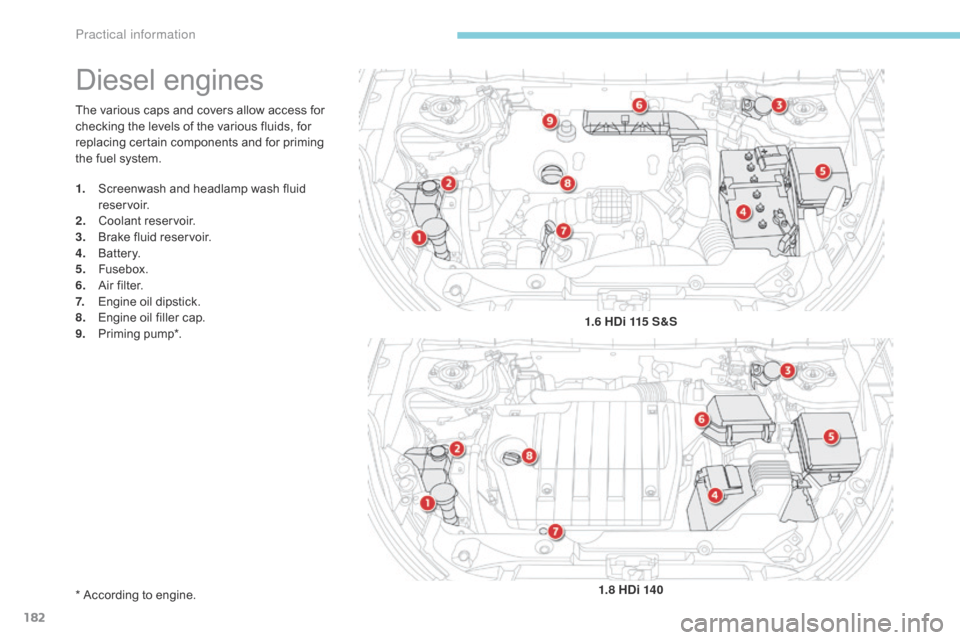
182
C4-Aircross_en_Chap07_info-pratiques_ed01-2016
The various caps and covers allow access for
checking the levels of the various fluids, for
replacing certain components and for priming
the fuel system.
Diesel engines
1. Screenwash and headlamp wash fluid reservoir.
2.
C
oolant reservoir.
3.
B
rake fluid reservoir.
4.
B
attery.
5.
F
usebox.
6.
A
ir filter.
7.
E
ngine oil dipstick.
8.
E
ngine oil filler cap.
9.
P
riming pump*. 1.6
HDi 115 S&S
1.8 HDi 140
* According to engine.
Practical information
Page 185 of 368
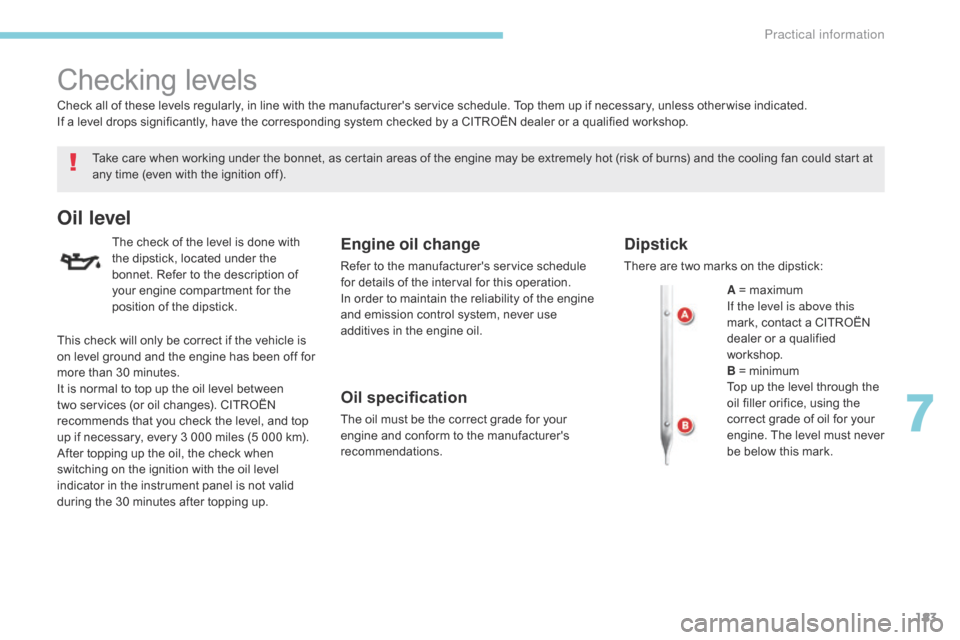
183
C4-Aircross_en_Chap07_info-pratiques_ed01-2016
Checking levels
Take care when working under the bonnet, as certain areas of the engine may be extremely hot (risk of burns) and the cooling fan could start at
any time (even with the ignition off).
Oil level
The check of the level is done with
the dipstick, located under the
bonnet. Refer to the description of
your engine compartment for the
position of the dipstick.Engine oil change
Refer to the manufacturer's service schedule
for details of the interval for this operation.
In order to maintain the reliability of the engine
and emission control system, never use
additives in the engine oil.
Oil specification
The oil must be the correct grade for your
engine and conform to the manufacturer's
recommendations.
Check all of these levels regularly, in line with the manufacturer's service schedule. Top them up if necessary, unless other wise indicated.
If a level drops significantly, have the corresponding system checked by a CITROËN dealer or a qualified workshop.
Dipstick
There are two marks on the dipstick:
A = maximum
If the level is above this
mark, contact a CITROËN
dealer or a qualified
workshop.
B = minimum
Top up the level through the
oil filler orifice, using the
correct grade of oil for your
engine. The level must never
be below this mark.
This check will only be correct if the vehicle is
on level ground and the engine has been off for
more than 30 minutes.
It is normal to top up the oil level between
two services (or oil changes). CITROËN
recommends that you check the level, and top
up if necessary, every 3 000 miles (5 000 km).
After topping up the oil, the check when
switching on the ignition with the oil level
indicator in the instrument panel is not valid
during the 30 minutes after topping up.
7
Practical information
Page 186 of 368
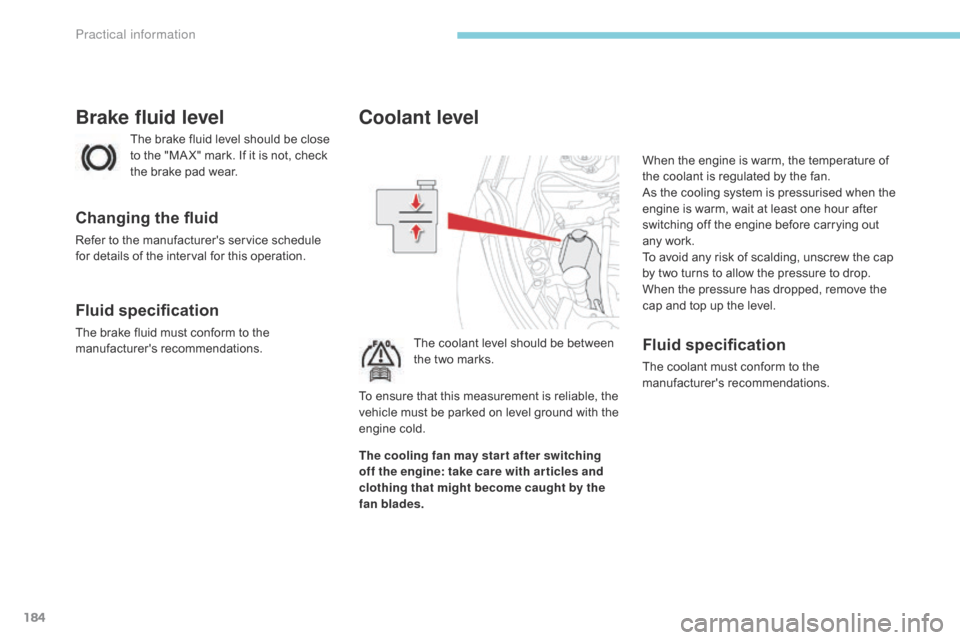
184
C4-Aircross_en_Chap07_info-pratiques_ed01-2016
Coolant level
The coolant level should be between
the two marks.When the engine is warm, the temperature of
the coolant is regulated by the fan.
As the cooling system is pressurised when the
engine is warm, wait at least one hour after
switching off the engine before carrying out
any
work.
To avoid any risk of scalding, unscrew the cap
by two turns to allow the pressure to drop.
When the pressure has dropped, remove the
cap and top up the level.Fluid specification
The coolant must conform to the
manufacturer's recommendations.
The brake fluid level should be close
to the "MA X" mark. If it is not, check
the brake pad wear.
Brake fluid level
Changing the fluid
Refer to the manufacturer's service schedule
for details of the interval for this operation.
Fluid specification
The brake fluid must conform to the
manufacturer's recommendations.
The cooling fan may star t after switching
off the engine: take care with ar ticles and
clothing that might become caught by the
fan blades. To ensure that this measurement is reliable, the
vehicle must be parked on level ground with the
engine cold.
Practical information
Page 187 of 368
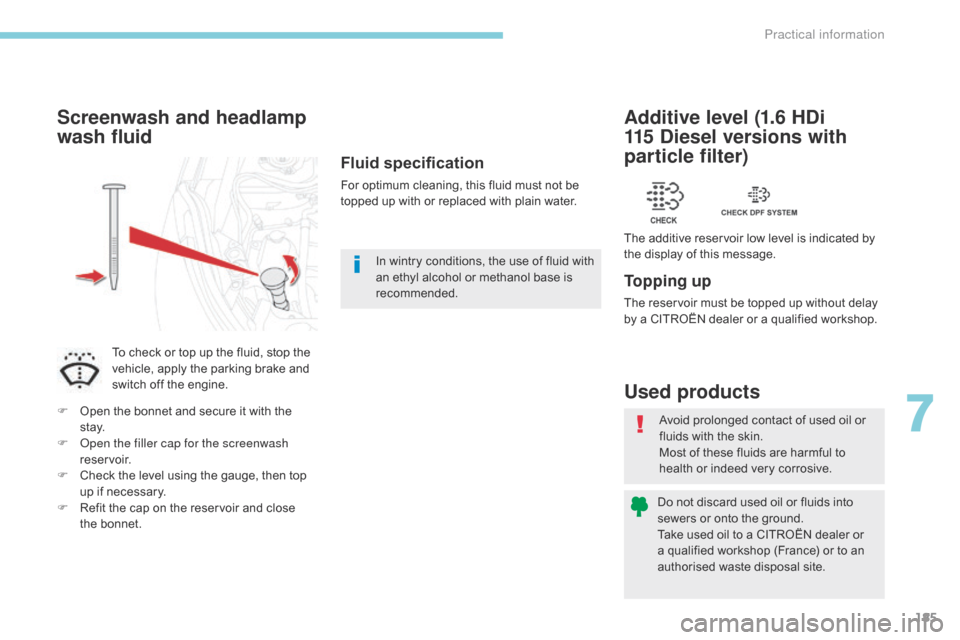
185
C4-Aircross_en_Chap07_info-pratiques_ed01-2016
Avoid prolonged contact of used oil or
fluids with the skin.
Most of these fluids are harmful to
health or indeed very corrosive.
Do not discard used oil or fluids into
sewers or onto the ground.
Take used oil to a CITROËN dealer or
a qualified workshop (France) or to an
authorised waste disposal site.
Used products
To p p i n g u p
The reservoir must be topped up without delay
by a CITROËN dealer or a qualified workshop.
Additive level (1.6 HDi
115 Diesel versions with
particle filter)
The additive reservoir low level is indicated by
the display of this message.
Fluid specification
For optimum cleaning, this fluid must not be
topped up with or replaced with plain water.
Screenwash and headlamp
wash fluid
To check or top up the fluid, stop the
vehicle, apply the parking brake and
switch off the engine.
F
O
pen the bonnet and secure it with the
st ay.
F
O
pen the filler cap for the screenwash
reservoir.
F
C
heck the level using the gauge, then top
up if necessary.
F
R
efit the cap on the reservoir and close
the
bonnet. In wintry conditions, the use of fluid with
an ethyl alcohol or methanol base is
recommended.
7
Practical information